
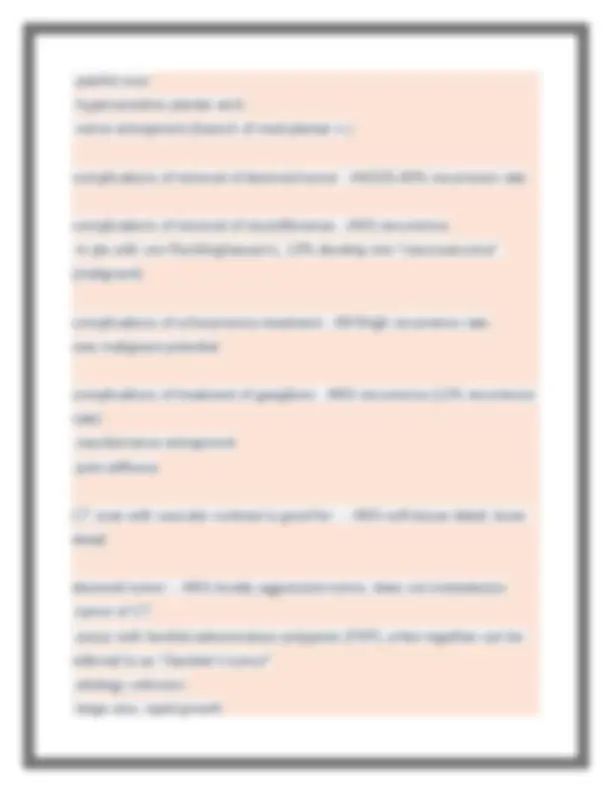
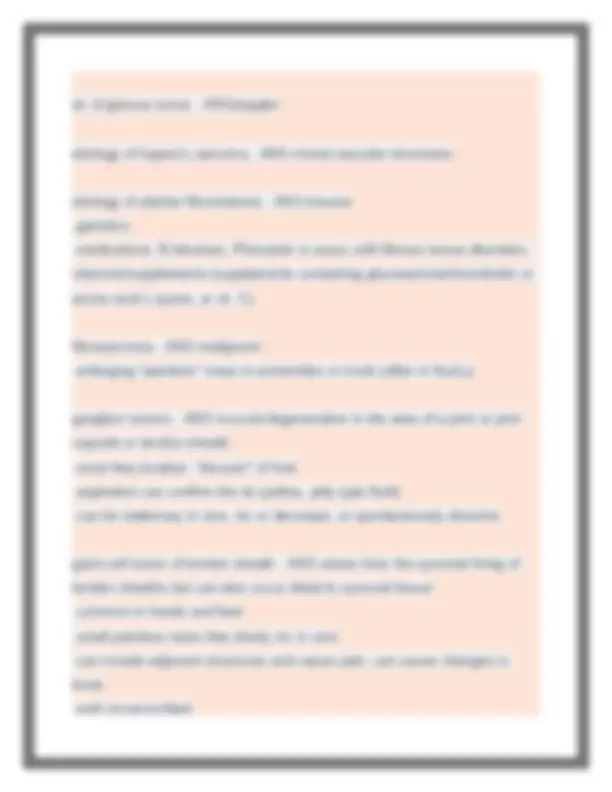
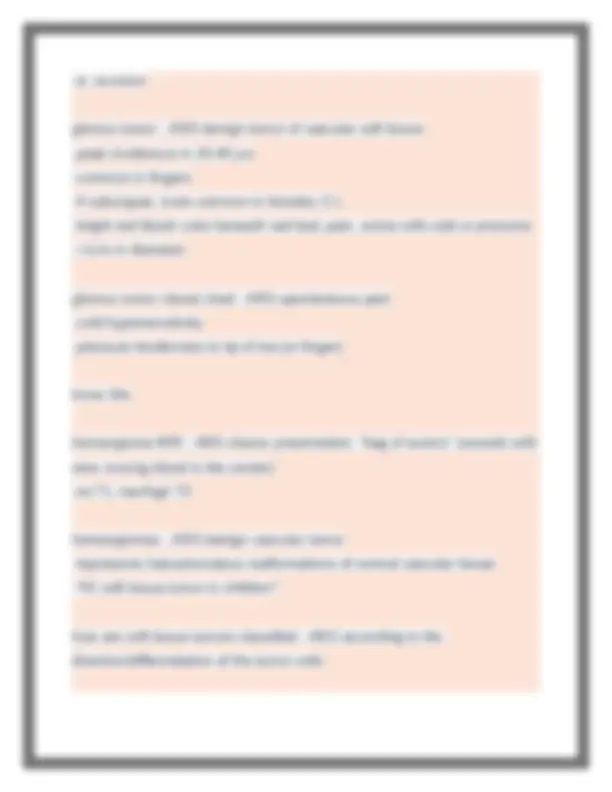
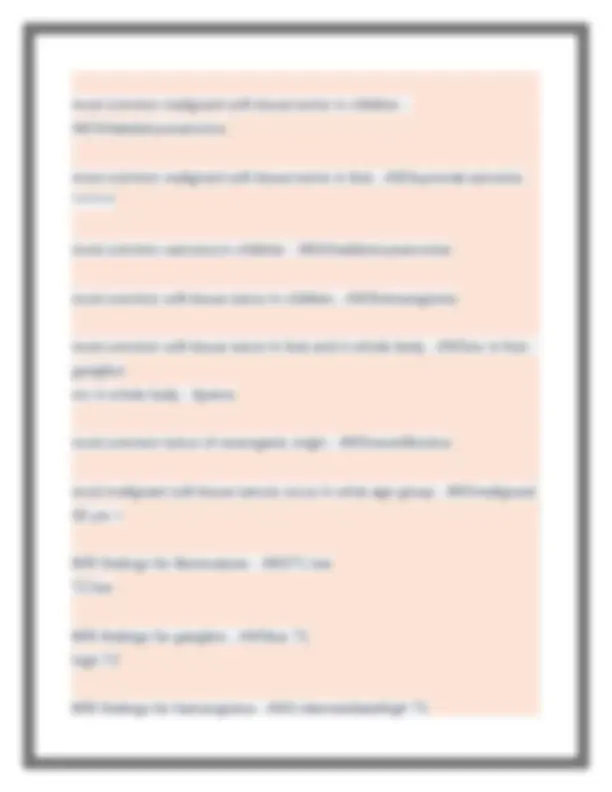
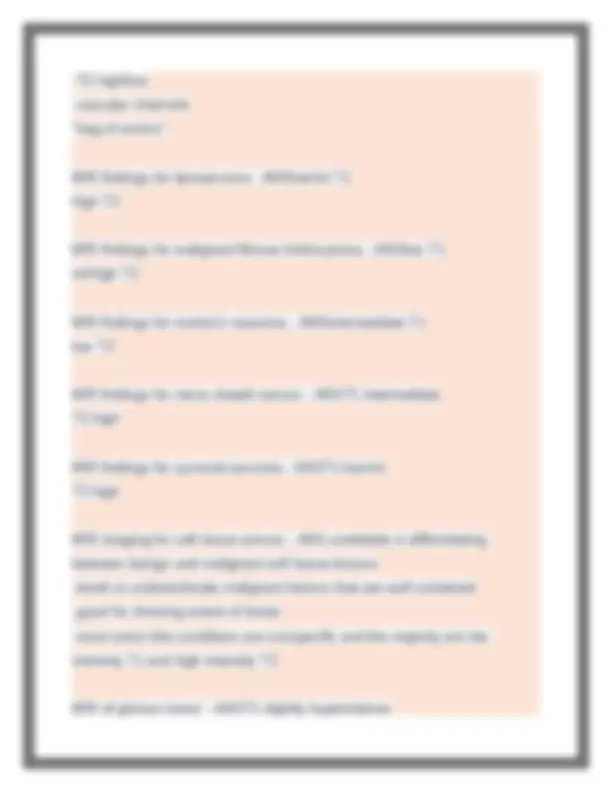
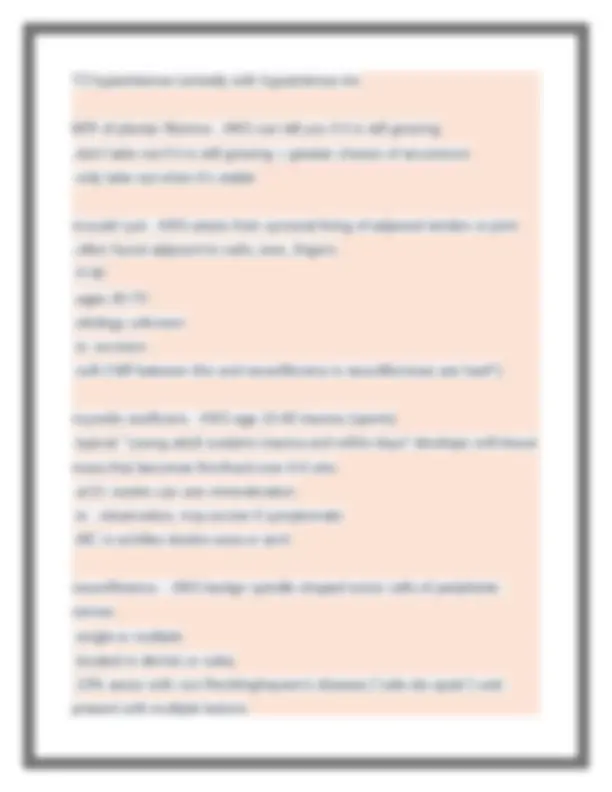
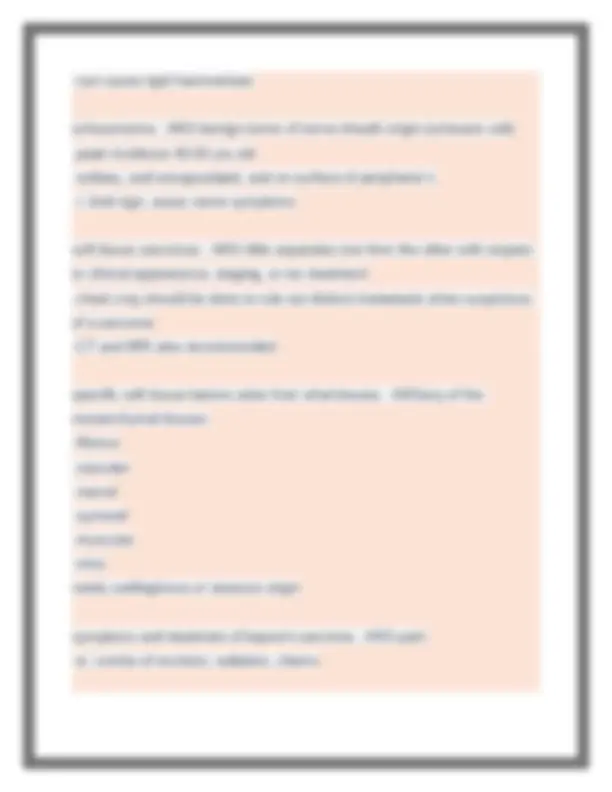
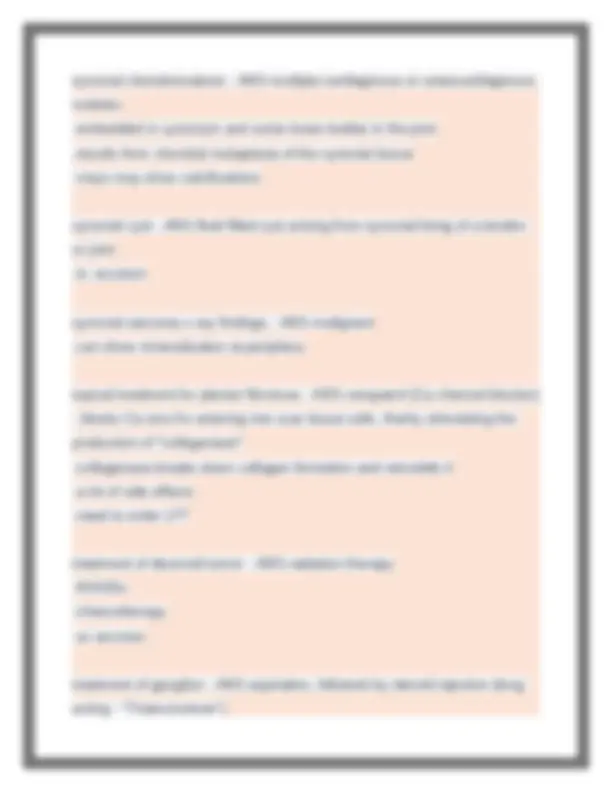
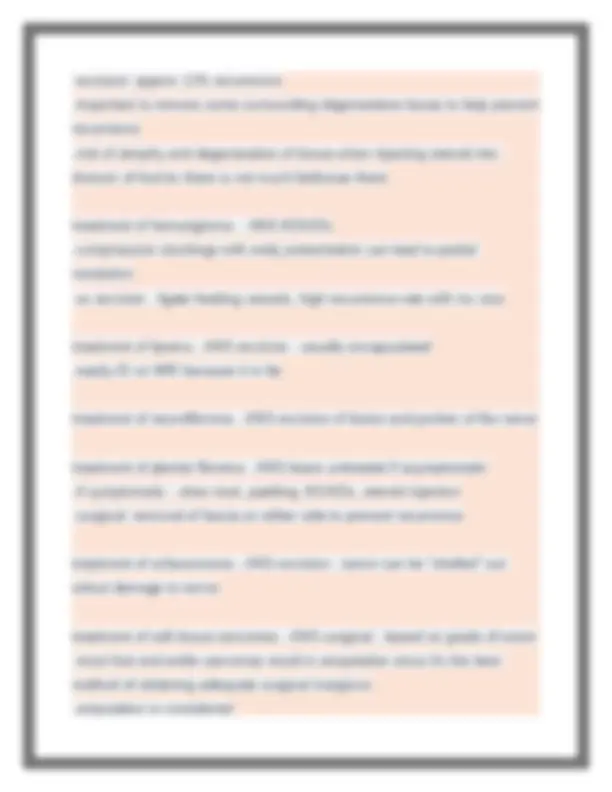



Study with the several resources on Docsity

Earn points by helping other students or get them with a premium plan


Prepare for your exams
Study with the several resources on Docsity

Earn points to download
Earn points by helping other students or get them with a premium plan
Community
Ask the community for help and clear up your study doubts
Discover the best universities in your country according to Docsity users
Free resources
Download our free guides on studying techniques, anxiety management strategies, and thesis advice from Docsity tutors
Soft Tissue Tumors of the Foot and Ankle Questions and Correct Answers 2025-2026 Graded A
Typology: Exams
1 / 18

This page cannot be seen from the preview
Don't miss anything!











"SCARE tumors" - ANS-synovial sarcoma -clear cell sarcoma -angiosarcoma -rhabdosarcoma -epithelioid sarcoma malignant tumors that occur in younger age group (20-40 yrs) anemia can be seen in pts with what types of soft tissue tumors - ANSwith early malignant tumors such as Ewing's sarcoma, angiosarcoma, fibrous histiocytoma benign fat tumors include - ANS-lipoma -angiolipoma benign fibrous tumors include - ANS-periungual fibromas (can sometimes be seen in tuberous sclerosis) -plantar fibroma/fibromatosis -desmoid tumor benign neural soft tissue tumors include - ANS-neurofibroma -schwannoma (neurilemoma)
benign soft tissue in muscle - ANSleiomyoma (smooth m) rhabdomyoma (skeletal m) benign synovial soft tissue tumors include - ANS-ganglion (most common in foot) -giant cell tumor of tendon sheath -mucoid cyst (mucinous cyst) -synovial cyst -pigmented villonodular synovitis -synovial chondromatosis - multiple cartilaginous nodules benign vascular soft tissue tumors include - ANS-glomus -hemangioma clincal evaluation of ganglion - ANS-freely movable -nonpainful -translucent upon illumination -usually attached to a tendon or joint capsule clinical workup of a soft tissue tumor: primary - ANS-palpate it -x-rays -CT/MRI -biopsy complciations of surgical removal of plantar fibroma - ANS-recurrence: 33%
dx of glomus tumor - ANSdoppler etiology of kaposi's sarcoma - ANS-mixed vascular structures etiology of plantar fibromatosis - ANS-trauma -genetics -medications: B-blockers, Phenytoin is assoc with fibrous tissue disorders, vitamins/supplements (supplements containing glucosamine/chondroitin or amino acid L-lysine, or vit. C) fibrosarcoma - ANS-malignant -enlarging painless mass in extremities or trunk (often in foot) p ganglion tumors - ANS-mucoid degeneration in the area of a joint or joint capsule or tendon sheath -most freq location: dorsum of foot -aspiration can confirm the dx (yellow, jelly type fluid) -can be stationary in size, inc or decrease, or spontaneously dissolve giant cell tumor of tendon sheath - ANS-arises from the synovial lining of tendon sheaths but can also occur distal to synovial tissue -common in hands and feet -small painless mass that slowly inc in size -can invade adjacent structures and cause pain; can cause changes in bone -well circumscribed
-tx: excision glomus tumor - ANS-benign tumor of vascular soft tissue -peak incidencce in 20-40 yrs -common in fingers -if subungual, more common in females 3: -bright red-bluish color beneath nail bed, pain, worse with cold or pressure ->1cm in diameter glomus tumor classic triad - ANS-spontaneous pain -cold hypersensitivity -pressure tenderness to tip of toe (or finger) know this hemangioma MRI - ANS-classic presentation: "bag of worms" (vessels with slow moving blood in the center) -int T1, low/high T hemangiomas - ANS-benign vascular tumor -represents hamartomatous malformations of normal vascular tissue -#1 soft tissue tumor in children how are soft tissue tumors classified - ANS-according to the direction/differentiation of the tumor cells
malignant vascular soft tissue tumors include - ANS-kaposi's sarcoma -angiosarcoma and variants -lymphangiosarcoma massive localized lymphedema - ANS-occurs in morbidly obese ppl usually over 300 lbs -overlying skin has "peau d'orange" appearance metastasis workup for soft tissue tumor (if you suspect a tumor has metastasized) - ANS-bone scan -CXR, CT of chest, abdomen, pelvis -basic chemistry to include Ca, Phosphorus, LFTs, electrophoresis most benign soft tissue tumors occur in what age group? malignant age group? exceptions? - ANS-benign: 20-40 yrs -malignant: 40+ -except "SCARE" tumors and peripheral nerve sheath tumors most benign tumors of soft tissue occur in what age group - ANSbenign: 20-40 yrs except "SCARE" tumors and peripheral nerve sheath tumors most common benign soft tissue tumor in adults - ANSlipoma most common benign soft tissue tumor in foot - ANSganglion
most common malignant soft tissue tumor in children - ANSrhabdomyosarcoma most common malignant soft tissue tumor in foot - ANSsynovial sarcoma
most common sarcoma in children - ANSrhabdomyosarcoma most common soft tissue tumor in children - ANShemangioma most common soft tissue tumor in foot and in whole body - ANSmc in foot - ganglion mc in whole body - lipoma most common tumor of neurogenic origin - ANSneurofibroma most malignant soft tissue tumors occur in what age group - ANSmalignant: 40 yrs + MRI findings for fibromatosis - ANST1 low T2 low MRI findings for ganglion - ANSlow T high T MRI findings for hemangioma - ANS-intermediate/high T
T2 hyperintense centrally with hypointense rim MRI of plantar fibroma - ANS-can tell you if it is still growing -don't take out if it is still growing = greater chance of recurrence -only take out when it's stable mucoid cyst - ANS-arises from synovial lining of adjacent tendon or joint -often found adjacent to nails, toes, fingers -F>M -ages 40- -etiology unknown -tx: excision -soft (diff between this and neurofibroma is neurofibromas are hard) myositis ossificans - ANS-age 10-40 trauma (sports) -typical: young adult sustains trauma and within days develops soft tissue mass that becomes firm/hard over 4-6 wks -at 6+ weeks can see mineralization -tx - observation; may excise if symptomatic -MC in achilles tendon area or arch neurofibrama- - ANS-benign spindle shaped tumor cells of peripherla nerves -single or multiple -located in dermis or subq -10% assoc with von Recklinghausen's disease ("cafe ole spots") and present with multiple lesions
-can be assoc with scoliosis, local gigantism, tibial pseudoarthritis periungual fibromas - ANS-benign -common in the toes -single or multiple -bleed easily when cut -can cause nail deformity due to pressure -tx: excision; can re-occur pertinent history for a soft tissue tumo - ANS-how long has it been present (quick growing, large tend to be malignant) -is it causing pain? usually no -hx of trauma or foreign bodies? -systemic signs or lab findings? -hx of cancer/family hx? physical exam of a soft tissue tumor - ANS-palpate lesion -palpate LNs -firm lesions >5cm in diameter are assumed to be malignant pigmented villonodular synovitis - ANS-often occurs around joints, tendon sheaths, or bursal linings -intermittent edema ocurs, minimal discomfort -aspiration: bloody or brownish fluid with little/no decrease in size bc of residual capillary thickening plantar fibroma features - ANS-can be painful on WB
-can cause rigid hammertoes schwannoma - ANS-benign tumor of nerve sheath origin (schwann cell) -peak incidence 40-50 yrs old -solitary, well encapsulated, and on surface of peripheral n. -+ tinel sign, assoc nerve symptoms soft tissue sarcomas - ANS-little separates one from the other with respect to clinical appearance, staging, or rec treatment -chest xray should be done to rule out distinct metastasis when suspicious of a sarcoma -CT and MRI also recommended specific soft tissue lesions arise from what tissues - ANSany of the mesenchymal tissues: -fibrous -vascular -neural -synovial -muscular -misc rarely cartilaginous or osseous origin symptoms and treatment of kaposi's sarcoma - ANS-pain -tx: combo of excision, radiation, chemo
synovial chondromatosis - ANS-multiple cartilaginous or osteocartilaginous nodules -embedded in synovium and some loose bodies in the joint -results from chondral metaplasia of the synovial tissue -xrays may show calcifications synovial cyst - ANS-fluid filled cyst arising from synovial lining of a tendon or joint -tx: excision synovial sarcoma x-ray findings - ANS-malignant -can show mineralization at periphery topical treatment for plantar fibromas - ANS-verapamil (Ca channel blocker)
triad for tuberous sclerosis - ANSfacial angiofibromas mental deficiency seizures tuberous sclerosis - ANS-multisystem disease where pts develop fibromas anywhere on the body (brain, toes, skin, etc.) -triad: facial angiofibromas, mental deficiency, seizures -multiple perinugual fibromas on the toes know the triad tx of glomus tumor - ANSexcision tx of pigmented villonodular synovitis - ANS-when bone is involved, a synovectomy is done -radiation therapy used in conjunction -recurrence common tx of synovial chondromatosis - ANSsynovectomy and excision of all bodies complciations: recurrence, DJD types of hemangiomas - ANS-cavernous -capillary portwine type most common at birth, regress spontaneously -mixed type
what is the best soft tissue diagnostic test - ANSMRI - best for soft tissue detail and for defining marrow involvement in osseous lesions what is the most common sarcoma found in the foot - ANSsynovial sarcoma *** what is the most common tumor of neurogenic origin - ANSneurofibroma when should you assume a soft tissue tumor to be malignant? - ANSif it is firm and >5cm where do soft tissue tumors form - ANS-in CT (muscles, tendons, fat, skin) -can also form in bones x-ray findings of a hemangioma - ANS-benign -can contain phleboliths (calcifications of small blood vessels) x-ray findings of a lipoma - ANS-benign -can contain islands of mature bone x-ray of soft tissue tumors - ANS-can detect mineralization in the soft tissue lesion and changes to underlying bone -both benign and malignant tumors can undergo mineralization xray of glomus tumor - ANS-well marginated, bony erosion over the dorsal aspect of the distal phalanx -bony erosion may indicate malignancy, but glomust tumors are benign